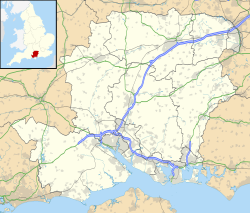Top Qs
Timeline
Chat
Perspective
Cowplain
Village in Hampshire, England From Wikipedia, the free encyclopedia
Remove ads
Cowplain is a village located north of Waterlooville, Hampshire, in South East England. According to the 2011 United Kingdom census, Cowplain is reported to have a population of 9,353,[1] which constitutes 7% of the total population of the Borough of Havant. The village is spread along the A3 road connecting London to Portsmouth.[citation needed]
This article needs additional citations for verification. (July 2025) |
Remove ads
Geography
In 1810, the area which would become the village site was recorded as part of the formerly uninterrupted Forest of Bere. The only existing building at the time was Padnell Brick Kiln (later renamed Padnell Farm, then Padnell Grange).[citation needed] The village is located in a partially forested area, of which The Queen's Inclosure,[2] Padnell Cuts Woods, Idlewood, Hurstwood, and Park Woods are portions. The village was founded at the foot of the nearby hill[which?], where The Spotted Cow Pub was originally built (c. 1860), from which the village's name is believed to have originated.[3][citation needed] Villages situated in close proximity of Cowplain are Lovedean, Rowland's Castle, Denmead and Horndean. Wecock Farm, a 1970s Portsmouth City Council housing estate, is located west of Cowplain.
Remove ads
Services
This section needs additional citations for verification. (July 2025) |
Cowplain has several schools, including Cowplain School,[4] Padnell Infant[5] and Junior Schools,[6] Hartplain Infant[7] and Junior Schools,[8] and Queen's Inclosure Primary School,[9] which is adjacent to The Queen's Inclosure. Cowsplain is also home to St. Wilfrid's Church,[10][11] Cowplain Evangelical Church,[12] the Waterlooville Golf Course,[13] and a supermarket, formerly a Fine Fare store until its closure in 1988, which itself replaced the Harcourt stores at the Fernwood house development.
Remove ads
Transport
The construction of the Portsdown & Horndean Light Railway in 1903 accelerated the village's growth.[vague] The former tramline followed the route of the main A3 road and traversed Cowplain, where the main tram depot was built, before the line closed in 1935.[citation needed]
Subsequently, the tramline was replaced by the No. 42 Southdown bus, which was recently[when?] renumbered as No. 8. Cowplain is also served by the No. 37 bus passing from Havant to Clanfield and from Petersfield and Liss, the National Express No. 030 from Cowsplain to London, the No. 39 passing through Wecock Farm, and the First Group service 8 which follows the A3 from Clanfield to Gunwharf Quays in Portsmouth.
Train stations in close proximity of Cowplain include Havant Railway Station and Cosham Railway Station.
Notable people
- Mark Wingett, an English actor known for playing Police Constable Jim Carver in The Bill[citation needed], who attended Padnell Junior School
- Jill Ellis, an English-American football coach,[14] who attended Padnell Junior School and Cowplain School[citation needed]
- Gareth Southgate, an English footballer and team manager, who lived on the Hazleton Estate and briefly attended Padnell Infant school[citation needed]
Remove ads
References
External links
Wikiwand - on
Seamless Wikipedia browsing. On steroids.
Remove ads
